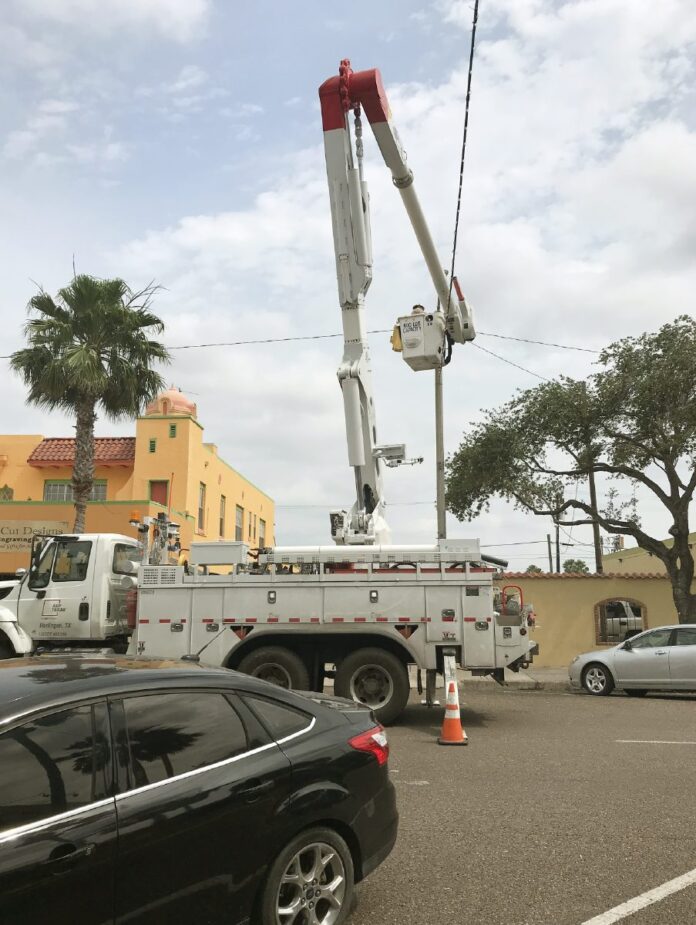HARLINGEN — Call it a plot to turn back the dark.
The city is engaging in a pilot program with AEP Texas to install 100 LED streetlights across the city each year until nearly 400 of them are glowing brightly along high-traffic streets.
To date, about 175 of the new lights have been installed over the past two years, with the latest batch lighting the night on Jackson Street in the downtown historic district since their installation last week.
“AEP is the company that is physically doing the replacements but we in the city identified the locations,” said Carlos Sanchez, assistant city manager for external affairs. “This year to date we’re at about 175, so there are another 25 or so that are still pending.”
Sanchez said the priority areas which are receiving the lights first are along Harrison and Tyler avenues and downtown, adding, “We’ll probably tackle Lincoln and Dixieland first, then Business 77.”
It’s no coincidence the first areas to receive the new lighting are along high-traffic, high-pedestrian commercial corridors in the city, and city officials say this should improve safety on those streets.
“It gives you a whiter, softer light,” Sanchez said yesterday. “And so that enhances visibility both for pedestrians and for motorists and that’s an added safety feature, and for security purposes too, it enhances that as well.”
Pedestrian safety
California, Florida and Texas have more pedestrian deaths than any other states, and so-called auto-ped accidents are believed to be increasing here in the Rio Grande Valley.
Over the past three years, TxDOT has funded millions of dollars worth of LED upgrades for I-2/U.S. 83 between Edinburg and Harlingen, and from San Benito to Brownsville on I-69E/U.S. 77. New LED lights also were installed along parts of I-69C.
“The LED upgrades done to the expressway are in conjunction with the product improvements currently in the market,” Octavio Saenz, a TxDOT spokesperson for the Pharr District, said yesterday via email. “LEDs do shine brighter and last longer, therefore it is logical that we use these in present and upcoming projects.
“As far as pedestrian safety, it is part of the safety mix throughout our roadways,” he said of the new lighting.
City’s costs
The cost to the city for installation of each of the light fixtures is $257.70. Installation of 100 LED lights per year will cost the city about $26,000 each fiscal year under the current program.
But according to the contract with AEP Texas, the power company is picking up installation costs, which other cities migrating to LED lighting have found can be higher than the cost of the lights themselves.
“What the city pays is a flat fee tariff to AEP, Sanchez said. “The LED lights are a little bit more energy efficient. The current rate that we pay for a light per month is $15.40. What AEP is proposing to charge us — and this is all part of a pilot program, because at the same time they are metering these lights to figure out the exact consumption — so right now they are charging us $11.81 per unit per month. So there’s a savings of about $3.59 per light fixture.”
City officials also are counting on added longevity, which is generally considered a feature of LED bulbs over conventional bulbs. They say they’re hoping for a minimum of at least 10 years before LED lights need replacing.
“The LED light fixtures can last anywhere from 10, 15, maybe sometimes 20 years, especially street lights, being that they’re not going to be constantly on” Sanchez said. “The manufacturer will tell you 10 years because they want to err on the conservative side, but they mentioned it could be up to 15 or maybe more years.
“That’s where you see some of the payback,” he added.
Benefits of LED lights
• Shine brighter
• Last longer
• More energy efficient
• Improves safety for pedestrians, motorists
Streetlight history
• Introduced in United States by inventor Benjamin Franklin, then postmaster of Philadelphia.
• These colonial-era streetlights were lit by candles burning inside a glass vessel, which kept the candle from being blown out by wind. Franklin’s innovative design was four-sided, with four separate panes of glass, so that if one pane of glass broke, the entire lamp’s glass did not need to be replaced and the candle might not even blow out.
• After the invention of gas lighting by William Murdoch in 1792, cities in Great Britain began to light their streets using gas. The United States followed suit with the introduction of gas lighting on Pelham Street in Newport, Rhode Island, in 1803. Throughout the 19th century, the use of gas lighting increased. Some locations in the U.S. still use gas lights.
• After Thomas Edison pioneered electric light bulbs for home use, they were developed for streetlights, too. The first city to use electric streetlights was Wabash, Indiana. Charles F. Brush of Cleveland, Ohio, wanted to publicly test his new invention called the “Brush Light” and needed a city guinea pig. Wabash agreed to test the lights and on March 31, 1880, Wabash became the first electrically-lighted city in the world.
• Fluorescent and incandescent lights became popular during the 1930s and 1940s, when automobile travel began to accelerate. A street with lights was referred to as a “white way” during the early 20th century.
Source: Wikipedia




